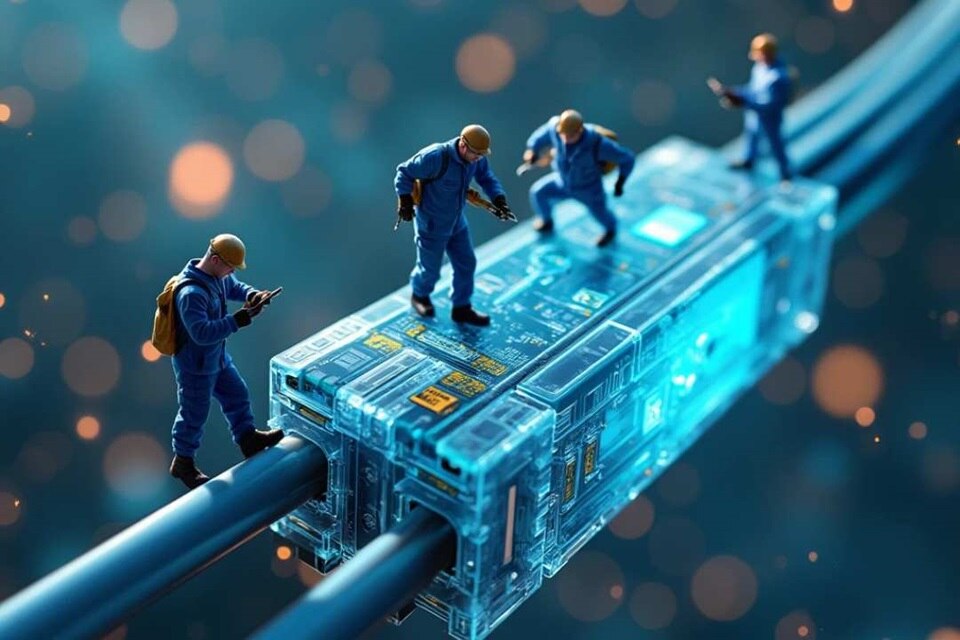How AI is transforming the construction industry and optimising energy consumption
Artificial intelligence is revolutionising the construction industry by optimising processes, reducing errors and improving energy efficiency. From design to maintenance, these technologies enable more accurate, sustainable and cost-effective management of projects and buildings.

The impact of AI on the construction industry
Transforming construction processes
Artificial intelligence is disrupting traditional methods in the construction industry, providing solutions that are profoundly transforming site management. Thanks to automation, teams can now optimise every stage of a project, from planning to execution. AI algorithms enable precise resource allocation and better coordination between subcontractors, reducing human error and delays. For example, by analysing data in real time, these systems quickly identify anomalies or inefficiencies, significantly improving operational efficiency. The result? A significant reduction in overall costs, while increasing the quality of deliverables.
Furthermore, the integration of technologies such as 3D modelling and BIM (Building Information Modelling) has revolutionised architectural and structural design. These tools allow engineers and project managers to simulate various scenarios before construction even begins. With these simulations, it becomes possible to assess the technical feasibility of a project upstream, anticipate constraints and ensure smooth progress. By combining this approach with AI programmes, the sector gains in precision and flexibility, providing teams with a clear and realistic view of upcoming operations.
Reducing carbon emissions through optimisation
The climate emergency is pushing the construction industry to adopt more sustainable practices, and AI is emerging as an essential lever for achieving these goals. By optimising the energy consumption of buildings from the design stage, intelligent systems can significantly reduce their carbon footprint. These programmes analyse local climate data and propose appropriate energy configurations, thereby promoting the rational use of resources. In addition, artificial intelligence makes it possible to identify sustainable materials that combine thermal performance with low environmental impact.
At the same time, AI plays a crucial role in waste management on construction sites. Smart sensors installed on site collect real-time data to monitor recycling and optimise the transport of unused materials. These systems promote sustainable construction, minimising not only transport-related emissions but also waste treatment costs. This innovative approach also encourages a rethink of traditional methods to incorporate more environmentally friendly practices.
Artificial intelligence solutions for sustainability
Use of sensors for real-time data collection
In an industry where every minute counts, smart sensors are revolutionising infrastructure management by providing real-time data. These devices, integrated into buildings and construction sites, enable continuous and accurate monitoring of various parameters such as humidity, temperature and structural vibrations. With this information, teams can anticipate maintenance needs and avoid costly breakdowns. This is known as predictive maintenance, a concept based on trend analysis to intervene before a problem arises. This not only reduces maintenance costs but also extends the life of infrastructure.
The impact of these sensors does not stop there. By combining their data with AI-powered analytics platforms, it becomes possible to optimise the use of energy and material resources. For example, a system can automatically adjust heating or air conditioning based on actual building occupancy, reducing energy consumption without compromising occupant comfort.
Automation methods for efficient maintenance
Artificial intelligence goes even further in the field of maintenance through automation. Robots and drones equipped with advanced technologies are now used to carry out inspections on construction sites or in hard-to-reach areas. These automated tools collect high-resolution images and accurate data, which are then analysed by AI programmes to quickly detect anomalies or structural damage. This not only enables rapid intervention but also significantly reduces risks to human workers.
In addition, these automated systems are capable of proposing optimised action plans based on an in-depth assessment of the data collected. For example, a drone can identify a crack on an exterior wall and immediately transmit this information to a dedicated team who can then plan a targeted repair. This approach not only improves overall efficiency but also reduces waste of materials and other resources.
Collaboration between companies and AI in construction
Scalable tools to improve productivity
The introduction of artificial intelligence software in the construction industry has paved the way for significantly improved project management. These tools enable optimised resource allocation, taking into account the specific constraints of each construction site. For example, an AI programme can analyse thousands of data points related to work progress, team performance and deadlines to propose a real-time adjusted execution plan. This ability to adapt strategies as the project progresses helps reduce unforeseen events and significantly increase overall efficiency.
In addition, by automating certain repetitive administrative tasks such as schedule management and performance evaluation, this software frees up valuable time for project managers and teams. They can then focus on more strategic aspects such as coordinating with subcontractors or resolving complex problems. This synergy between humans and technology is transforming collaborative work, making each step of the process smoother and more efficient.
Innovative projects integrating artificial intelligence
The construction industry has recently seen the emergence of ambitious projects that fully integrate AI to design what are now known as smart buildings. These buildings use a combination of sensors, algorithms and connected systems to continuously adapt to the needs of their occupants. For example, a building can automatically adjust its lighting or ventilation based on the number of people present, reducing energy consumption while improving comfort.
AI also plays a key role in smart urban planning, where it is used to simulate different urban development scenarios before a project is even launched. This not only optimises the use of available land but also integrates environmentally friendly solutions from the design stage onwards. These innovations are not limited to large cities: they are also beginning to be adopted in rural areas to improve quality of life while minimising environmental impact.
Future prospects for AI in construction
Long-term goals for a sustainable environment
Artificial intelligence is positioning itself as a key player in the transition to sustainable development in the construction sector. AI-powered systems enable unparalleled levels of energy optimisation by identifying areas of waste and proposing tailored solutions to address them. For example, predictive analytics programmes can anticipate energy consumption peaks and adjust requirements accordingly, reducing environmental impact while controlling costs.
In addition, green AI, an approach that combines artificial intelligence with environmental friendliness, aims to develop less energy-intensive technologies. This initiative is part of a broader framework in which buildings themselves are becoming active contributors to the ecological transition. By integrating sustainable construction standards and complying with new environmental regulations, these smart solutions are transforming infrastructure into powerful levers for achieving global climate goals.
Evolution of materials and methods thanks to artificial intelligence
Innovation in the field of materials is also driven by artificial intelligence, which facilitates the development of smart materials capable of adapting to the specific needs of projects. For example, machine learning algorithms can analyse the chemical and mechanical properties of new composites to design more resistant, lighter and more environmentally friendly solutions. These advances are not only revolutionising traditional construction, but also paving the way for new approaches such as 3D printing in building.
In addition, modular construction methods, combined with AI-driven automation, are redefining industry standards. These techniques enable faster and more accurate manufacturing of prefabricated components, while significantly reducing material waste. By combining these innovations with optimised management through data analysis, the construction industry is entering an era where every decision is informed by a unique combination of technology and engineering.
